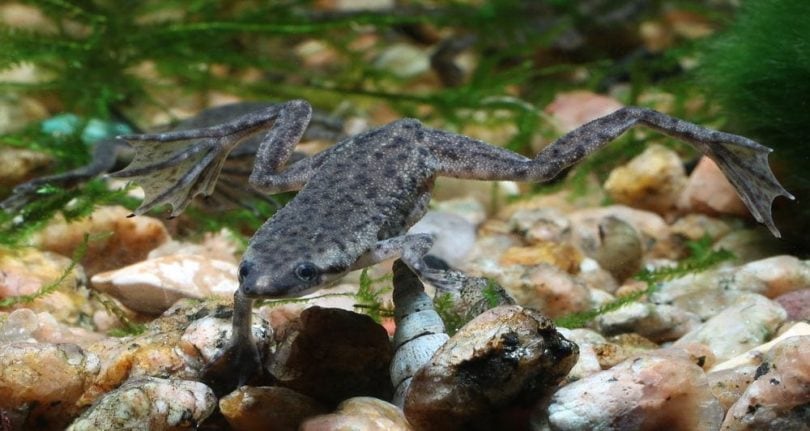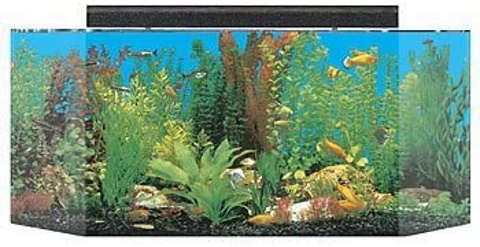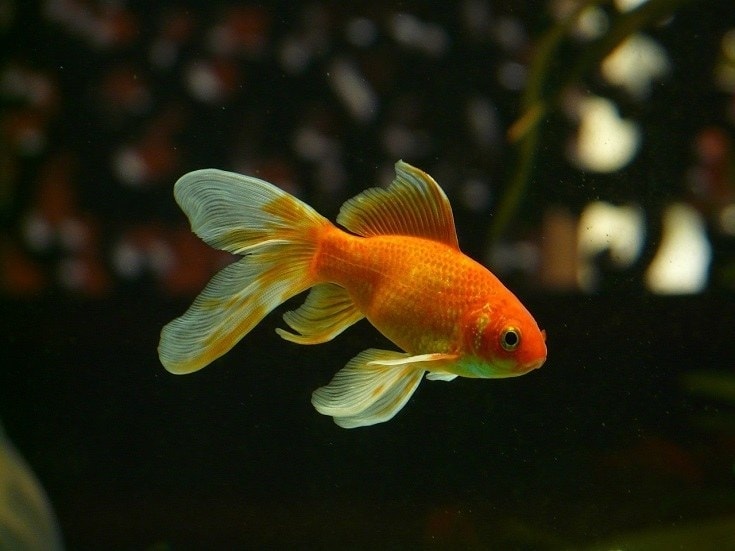Anubias Aquarium Plant: Care, Propagation & Types

Updated on
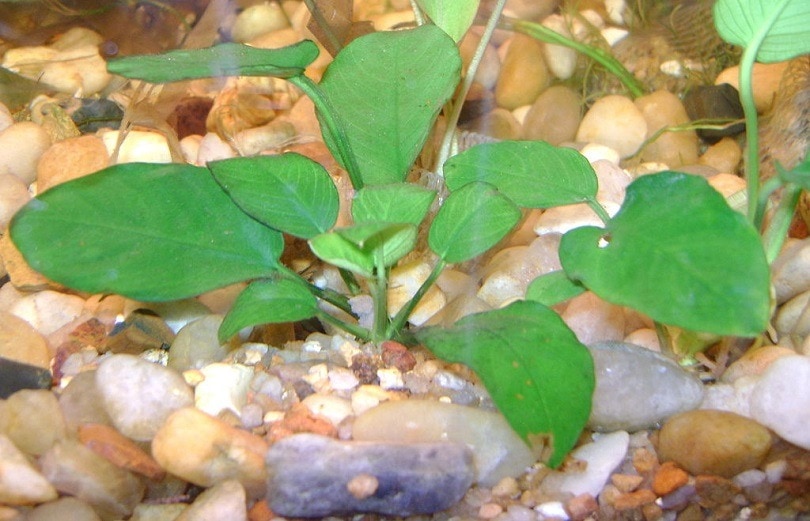
Anubias plants are a genus of aquatic and semi-aquatic plants native to tropical parts of Africa. There are over 20 varieties of Anubias, which means there is an Anubias variety for almost any freshwater tank.
Anubias are flowering plants, which can make them a beautiful centerpiece for your aquarium. Each variety has different leaf shapes and plant heights, which adds depth and interest even when not in bloom.
This genus of plants is named for the ancient Egyptian god of the afterlife, Anubis, which is a nod to its ability to grow in shaded, low-light environments. These plants are hardy and beautiful, requiring little maintenance.
If you have seen Anubias plants for sale in your local fish store and considered taking some home for your aquarium, here are the things you need to know.
Useful Information About Anubias
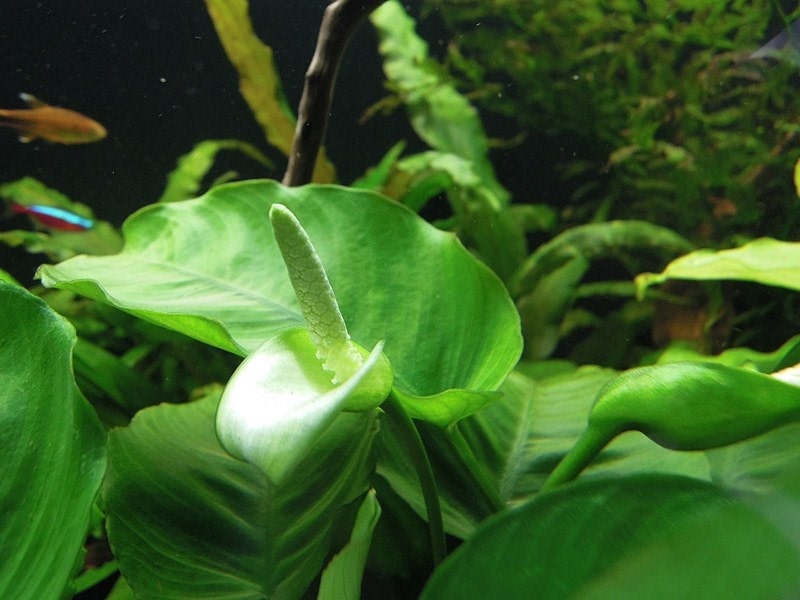
| Family Name: | Araceae |
| Common Name: | Anubias |
| Origin: | Central and western Africa |
| Color: | Various shades of green |
| Size: | 2–24 inches |
| Growth Rate: | Slow |
| Care Level: | Easy |
| Lighting: | Low to moderate |
| Water Conditions: | 70–82˚F
pH 6.0–7.5 |
| Minimum Tank Size: | 10 gallons |
| Supplements: | None |
| Placement: | Tank locations with driftwood or rocks |
| Propagation: | Rhizome division |
| Compatibility: | Tropical freshwater tanks |
Anubias Appearance
Anubias plants are flowering plants with leaves that are various shades of medium and dark green. The flowers are usually shades of white or yellow and are remarkably similar in appearance to the blooms of the Anubias’ cousin, Peace Lilies.
Anubias are rhizomatic plants, so they have noticeable, rhizome-based root systems branching from the bottom of the plant. Over time, these rhizomatic roots will attach the plant to surfaces like driftwood.
Most Anubias species have tall, pointed leaves that are similar in shape to a sword or knife. There is some variety in the leaf shapes between species, though.

Where to Find It?
Anubias plants are native to central and western Africa in tropical areas. These plants are not known to be invasive in the United States.
Different varieties of Anubias are readily available in online stores and brick-and-mortar stores alike. They are sold by large pet supply distributors, like Petco and PetSmart, as well as in smaller, local aquarium and pond stores.
General Care
While Anubias plants come in various shapes and sizes, they all have similar care needs. They can be propagated easily via rhizome division and prefer the same water parameters.
These plants are hardy to pH and temperature ranges outside of their preference, and they can grow successfully in soft or hard water. Moderate lighting will encourage faster growth than low lighting, although these plants will be slow-growth plants either way. Some studies have indicated that high lighting encourages faster Anubias growth, but this may also result in scorched leaves.
- Anubias nana is the smallest variety of Anubias plants, only reaching around 5–6 inches maximum height. They are excellent plants for carpeting driftwood and tank décor due to their preference for clumping growth with other nana plants. Unlike most Anubias plants, this species has petite, teardrop-shaped leaves. It comes in multiple dwarf varieties, including Anubias nana “petite” which reaches around 2 inches in height.
- Anubias gigantea is the largest variety of Anubias plants, able to reach 2 feet or more in height. This species does not grow well in indoor tank environments and usually stays below 18 inches in tanks. The leaves of gigantea can reach up to 6 inches in width and may encourage algae growth.
- Anubias barteri is the most common variety of Anubias seen in home tanks due to its attractive foliage, low cost, and wide availability. Its tall, pointed leaves can reach up to 12 inches in height, making this plant an option for middle and background placement in tanks. Most Anubias plants seen in tanks are Anubias barteri varieties, including Anubias nana.
- Anubias heterophylla is a lovely species of Anubias. It is the lightest shade of green that Anubias plants come in. Its leaves are long, up to 10 inches, but they are thinner than other Anubias varieties, giving them an elegant appearance.
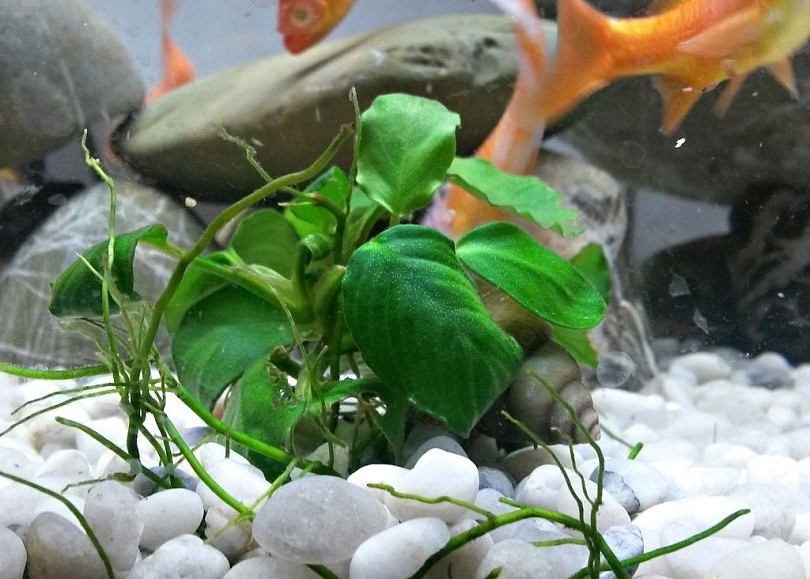
Habitat, Tank Conditions & Setup
Tank/Aquarium Size
Tank size for Anubias is variety dependent. The smallest Anubias, Anubias nana, can be kept in tanks that are 10 gallons, and can sometimes be kept in smaller environments. The largest variety of Anubias, Anubias gigantea, should only be kept in large tanks, 50 gallons or larger dependent on tank setup.
Water Temperature and pH
Since these plants are tropical, they all prefer tropical tank environments. Temperatures in the range of 70–82˚F will produce the best growth in Anubias plants. They grow best in soft water with a pH of 6.0–7.5 but are hardy to pH levels outside of this range.
Substrate
Anubias plants should not be planted in substrate. In the wild, they grow on rocks, roots, and driftwood in their environment. In the planted tank. Anubias plants should be attached to rocks, décor, or driftwood by string, aquarium-safe plant glue, or plant weights. Over time, the plant’s rhizomes will creep and attach the plant to the item.
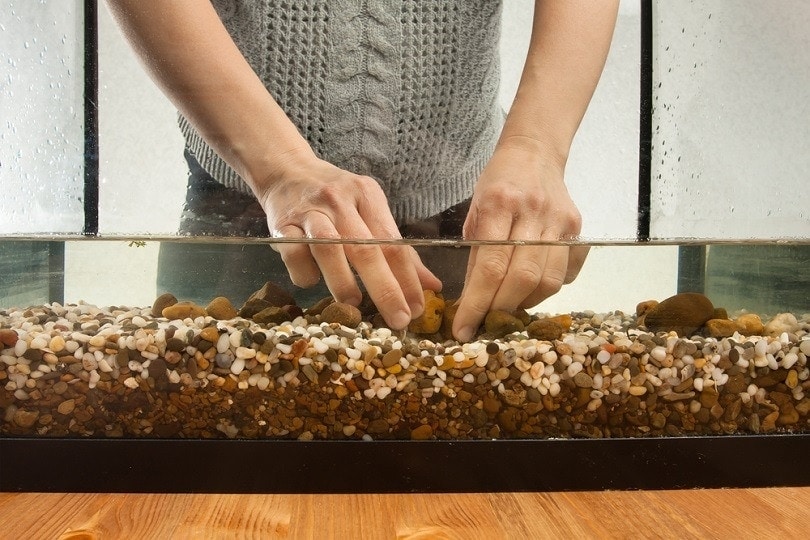
Plants
Anubias plants will grow well with other tropical, freshwater plants, like water lettuce and banana lilies.
Lighting
These plants can grow in low-light environments but will grow fastest in moderate lighting. Due to their low light requirement, tank lights may not be needed in rooms with good natural lighting.
Filtration
Anubias plants do not require filtration in their environment. If they are attached appropriately to items, they can survive in tanks with slow to moderate water currents.

Planting Tips
Anubias plants all require a surface to attach to. They absorb nutrients from the water via their rhizomatic root system, so they should not be planted into a substrate. If planted in a substrate, Anubias plants may not be able to absorb the necessary nutrients to grow or stay alive.
Tank placement of Anubias will depend on the Anubias species. Anubias nana only reaches a few inches in height, making it a good choice for front or middle tank placement. Larger varieties of Anubias may need to be placed further back in the tank to allow for better visualization inside the tank.
The 5 Benefits of Having Anubias in Your Aquarium
1. Water filtering
Anubias plants are excellent oxygenators and readily absorb toxins from the water, helping keep nitrate levels down.
2. Shelter
Many fish will find shelter in the leaves and stems of Anubias plants. These plants can provide cover for fry and may give nervous or unsure fish a sense of safety.
3. Hardiness
Anubias plants are hardy and can survive outside their preferred parameters, making them an excellent choice for beginner aquarists. More importantly, very few fish find Anubias plants appetizing. Even plant-killers like goldfish and cichlids will usually leave Anubias plants alone.
4. Shade
The broad, tall leaves of multiple Anubias species can function as shade for other plants and tank residents. Nocturnal fish, like Plecostomus, may take shelter in the shade of the leaves during daylight hours. In return, algae-eating fish will eat the algae from the slow-growing leaves of these plants, making this relationship symbiotic.
5. No substrate
One of the greatest benefits of Anubias is that it does not require an aquarium substrate. This makes it an exceptional tank choice for bare bottom tanks, which many people keep for their goldfish. This allows all the benefits of plants without the issues associated with substrates, like choking hazards and trapping waste.
Concerns About Anubias
There are very few concerns with Anubias plants, but due to their slow-growing nature and broad leaves, they may become a breeding ground for algae. This can be prevented with algae-eating fish or invertebrates and stocking the tank with other types of plants that will help the Anubias combat algae blooms.
If you choose to keep Anubias with low lighting, be sure to consider the other plants and animals in the tank. Most fish require 8 hours or more of light daily and low-light environments may impact their sleep/wake cycles and well-being. This can be remedied by keeping the tank in a room with adequate natural light or keeping moderate tank lighting since Anubias can thrive with this much light.
Final Thoughts
Anubias plants can be a beautiful addition to tanks. With the number of varieties of these plants that are available, you could stock your tank with nothing but Anubias plants and still have visible variety.
Providing a healthy environment for Anubias plants can reward you with beautiful flowers and a natural-looking tank. These plants are versatile and easy to care for, which makes them a good option for new or experienced aquarists.
The Anubias’ requirement for surfaces to attach to helps increase the visual depth and interest in the tank, helping to make your tank a work of art in your home.
Featured Image Credit: Anubias barteri var. nana (Image Credit: Carlosar, Wikimedia Commons CC BY-SA 3.0 Unported)



